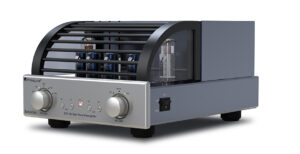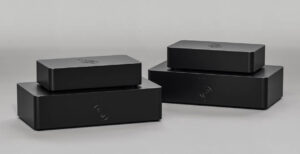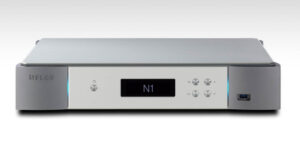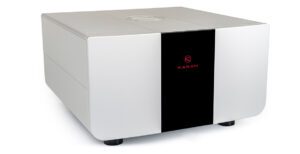
At the turn of the century, LP was all but dead (every magazine was headlining ‘final vinyl’ features), CD was king, and SACD was the challenger to its throne. So who would have imagined that a decade and a half later, it would be LP that might end up the last physical format standing? Vinyl’s reawakening in the 21st Century led to Electrocompaniet designing its first ever turntable, the ECG-1. It also led to the new ECP-2 balanced phono stage, which we shall be covering in a future issue.
There’s a lot of negativity in audio, and a brand best known for audio electronics making its first turntable in 2015 could be a target for that kind of negative thinking. The turntable could be seen as simply cashing in on the record-playing boom. Or, it could be considered to be a ‘make weight’ model, on the books simply to help complete the range and allow products like the ECP-2 to sell in Electrocompaniet specialist stores. However, the most cursory inspection proves the ECG-1 to be neither of those things, because that kind of cynical ‘design’ invariably involves placing the company’s logo on an OEM turntable, and the ECG-1 is not just a Pro-Ject or Rega design wearing Electrocompaniet’s distinctive gold on black livery.

Instead of adopting another company’s turntable, Electrcompaniet built the ECG-1 from first principles, adopting some of the anti-resonance and vibration control that went into products like the EMC 1-UP top-loading CD player (now in its EMC 1 MkIII SACD player guise), and applying them to the unique demands of the spinning vinyl disc. This becomes most notable in the chassis, which is a sandwich construction formed of a layer of aluminium between an upper and lower layer of acrylic. The acrylic layers are good for resonance damping and control, but require a more structurally sound aluminium layer to add the rigidity needed to keep the arm and bearing in alignment and, in the process, prevent any speed control issues from small changes in motor-to-platter placement.
The motor itself is a 24V asynchronous AC motor in its own housing, driven by an external two-phase speed controller. The motor housing stands almost completely independent of the main chassis, with only a single mini-DIN captive lead flying from the deck. This drives the basic speed controls in the Electrocompaniet’s signature four gold button layout – here, the buttons relate to turning the deck on or off, and 33, 45, and 78 rpm speed changes. There are no user adjustments to fine-tune speed.
Its platter is a thick acrylic design that sits deep in a recess in the top section of the chassis, and the belt sits around the outside of the platter. The belt, when first installed, can potentially slip under the platter and extracting it involves lifting the platter and the bearing housing; however, once installed the belt doesn’t ride up or down when playing.
Electrocompaniet may have started out with a clean sheet on the turntable, but when it comes to the choice of tonearm, the company turned to the tried and trusted 10”, oil-damped Jelco SA-750EB arm. Early reports also suggested the ECG-1 was to be bundled with a SoundSmith moving iron cartridge, but this seems to have been dropped from the final specification. This is both a good and a bad thing – good, because at this level most users will want to specify their own cartridge and will usually have the provision to install it, but bad because a SoundSmith moving iron is an almost perfect partner (I used it with Origin Live’s Aladdin cartridge from the same parentage, as well as a more meaty and historic Ortofon MC7500 to see what it was capable of). Fortunately, the arm is good for a wide range of cartridges, with masses between 4g and 12g.
Set-up is quick and easy, for a turntable. The feet are not level adjustable, though, and the turntable works best with a level, light, rigid, and vibration-free surface (a dedicated wall shelf is ideal).

It’s important to separate the ECG-1 from Electrocompaniet products, because the deck shouldn’t just be thought of as ‘the turntable for Electrocompaniet users’ but as a fine record player in its own right. However, Electrocompaniet also has a distinct family sound, and the ECG-1 is clearly a member of that family. There’s an unforced, easy, effortless sound common to many products in the range, and the ECG-1 follows that path, too. Never brash, the ECG-1 stresses the tonal beauty of a recording rather than leading edges. It’s more about musical and emotive insights rather than barefaced detail retrieval. If the performance is full of energy, it will portray that energy, but the ECG-1 is not a turntable that imposes its own ‘zing’ to the replay process.
This tonal (and timbral) integrity comes shining through with albums like Beck’s Sea Change album [Mobile Fidelity], where it’s all about the emotional content of the (mostly acoustic) music; but it also does surprisingly well with ‘Living For The City’ on Stevie Wonder’s legendary Innervisions [Tamla/Motown], because the ECG-1 deals with the lyrics, not just the rhythm. The rhythmic aspects of the album are still there, because the album would collapse without its driving sense of rhythm, and there is no sense of Stevie Wonder suffering a funkectomy (that came later in his career). Rather than stress the precision of the beat and that precision alone, the ECG-1 takes a more holistic view of the music. Those who define audio by ‘pace, rhythm, and timing’ will probably dismiss the ECG-1 as a result, but there are a lot of people who prefer a more complete picture, and one not dominated by one or two aspects of performance.
The ECG-1’s other great strength is spatial consistency. The soundstage cut into the groove is reproduced with tremendous accuracy. Whether it’s a close-knit jazz combo playing together on a small stage, or a full orchestra playing in a large auditorium, the ECG-1 is adept at scaling the soundstage presented to the amplifier up or down accordingly. Unless it’s on the recording, there’s no sense of 30m tall singers, stretched pianos, or tiny guitars. A lot of this comes from the ECG-1’s natural and unforced dynamic properties (it’s extremely good at portraying those ‘microdynamic’ sounds within a larger sound-field, such as the triangle playing in the overture to the Pirates of Penzance [Decca]) and from surprisingly good image solidity: instruments are rooted in their positions in the mix, unless the engineer is experimenting with the pan pot.
There’s a common theme emerging here, and one that holds well through the rest of the Electrocompaniet range: what the ECG-1 does is let you hear what went on in the studio. Not in a eviscerating manner (this isn’t the kind of turntable that makes you want to write to an engineer and question their choice of microphones); it simply lets you into the studio and the control room.
I dislike reviews that reference another product, but in this case I can’t help be sonically reminded of turntables like the Michell Gyro Dec. Both turntables have a sense of effortlessness about the performance; not ‘unable to shift out of low gear’ but instead the kind of audio presentation that doesn’t draw attention to itself, and just keeps on playing music happily for year upon year. This is, I suspect, one of the great strengths of the ECG-1: it’s not a player for those with Restless Ear Syndrome for whom any turntable is just a passing acquaintance. This is a turntable for keeps.
In a way, I’d love to see the ECG-1 available as a complete turnkey kit (with that SoundSmith cartridge) and just as a turntable with a range of cut-outs for different arms. The Jelco is fine and a perfect partner in its own right, but I can’t help thinking the ECG-1 is capable of partnering some really top-end arms like Mørch or even something as esoteric as a Graham. I think the turntable is potentially capable of that in its own right.
In the real world, however, I suspect Electrocompaniet has pitched the ECG-1 turntable and arm perfectly as a complete package, both in terms of absolute performance and in the context of an Electrocompaniet system. As a consequence, I doubt many would go for a deck without a matching tonearm, and the Jelco is a perfect match. At first, I thought I’d find the name ‘ECG’ irresistible in terms of knocking out a few electrocardiogram jokes: at the very least, I planned to play Queen’s Sheer Heart Attack on the turntable. But then it dawned on me the name is actually perfect for the Electrocompaniet
ECG-1 and no punning is necessary, because for many vinyl lovers old and new, this will be the heart of their system. The first turntable from the Norwegian audio brand comes strongly recommended.
Technical Specifications
- Turntable
- Operation: Manual
- Drive system: Exterior (round) rubber belt drive
- Motor: 24V AC synchronous motor
- Speeds: 33 1/3 – 45 – 78 RPM
- Speed selection: Fully regulated electronically
- Platter: 12” / 2.8 kg acrylic
- Tonearm
- Operation: Manual
- Profile: S–shaped
- Headshell: SME-mount
- Efficient length: 258 mm
- Overhang: 15.17 mm
- Offset angle: 21˚
- Tracking error – angle: 1.75˚–1.25˚
- Cartridge weight: 4–12 g
- Cartridge height: 38–60 mm
- Moving mass: 21 g (cartridge screws (0,5 g))
- Dimensions (W×D×H): 46.5×36×15.3cm
- Weight: 14.3 kg
- Price: £2,760
Manufactured by: Electrocompaniet
Tel: +47 51 74 10 33
Tags: FEATURED
By Alan Sircom
More articles from this authorRead Next From Review
See all
PrimaLuna EVO 100 phono preamplifier
- Apr 22, 2024

Reiki Audio SuperSwitch Master Pro + Servant Pro
- Mar 27, 2024

Melco Audio N1-S38 music server
- Mar 27, 2024











